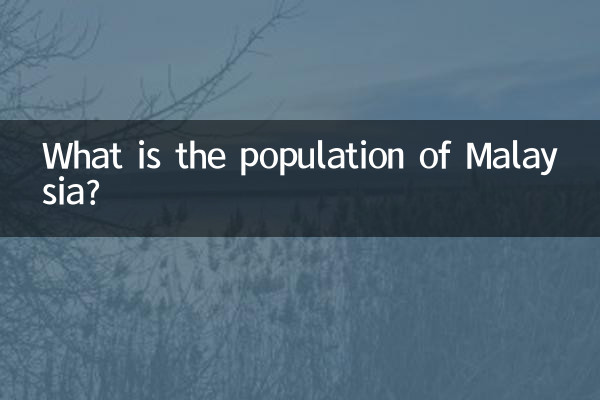What is the population of Malaysia? Analysis of the latest data and hot topics in 2024
As one of the important economies in Southeast Asia, Malaysia's demographic structure and changing trends have always been the focus of international attention. This article will combine the hot topics on the Internet in the past 10 days to give you a structured presentation of Malaysia’s latest population data and analyze relevant hot content.
1. Malaysia’s core population data in 2024

| index | numerical value | global ranking |
|---|---|---|
| total population | 34,041,000 people | No. 45 |
| male population | 17,426,000 people (51.19%) | - |
| female population | 16,615,000 people (48.81%) | - |
| population density | 103 people/square kilometer | No. 116 |
| annual growth rate | 1.34% | - |
| urban population ratio | 78.3% | - |
2. Analysis of population structure characteristics
1.Age distribution: Malaysia presents a typical "big in the middle and small at the two ends" structure, with the working-age population aged 15-64 accounting for 68.3%, and the elderly population over 65 accounting for only 7.1%, indicating that it is still in the demographic dividend period.
2.ethnic composition: Multicultural characteristics are remarkable, of which Malays account for 69.4%, Chinese account for 23.2%, Indians account for 6.7%, and other ethnic groups account for 0.7%. The new population policy recently announced by the government places special emphasis on the harmonious development of ethnic groups.
3.Geographical distribution: West Malaysia is home to 83% of the country’s population, with the population of the Kuala Lumpur-Klang Valley metropolitan area exceeding 8 million, making it one of the fastest growing metropolitan areas in Southeast Asia.
3. Correlation analysis of recent hot topics
1.Foreign labor policy controversy: There are approximately 2.8 million legal foreign workers in Malaysia, accounting for 8.2% of the total population. Recently, the government's plan to adjust the foreign worker quota system has triggered heated discussions, and the Ministry of Human Resources has stated that it will give priority to ensuring local employment.
2.brain drain problem: The World Bank report shows that about 2% of Malaysia’s highly skilled talents immigrate overseas every year, with Singapore being the main destination. The "Talent Return Plan" launched by the government has become a hot topic on social platforms.
3.Fertility rate changes: The total fertility rate will drop to 1.8 in 2023, below the replacement level. The #MalaysiaBabyChallenge topic on TikTok has accumulated more than 10 million views, reflecting the concerns of the younger generation about the cost of childbirth.
4. Population Development Forecast
| years | Projected population | Main characteristics of changes |
|---|---|---|
| 2025 | 34,850,000 | The aging index exceeded 15% |
| 2030 | 36,920,000 | The urbanization rate reaches 85% |
| 2050 | 41,500,000 | The population over 65 years old accounts for more than 20% |
5. Excerpts from expert opinions
Professor Ahmad Farooq, Director of the Population Research Institute of Universiti Kebangsaan Malaysia, said: "The next ten years will be a critical period for Malaysia’s demographic transition, need to balance economic growth and aging response. The current MyDIGITAL program is improving labor productivity through digital transformation. "
Economist Lin Zhiqiang analyzed: "Differences in population development between East and West MalaysiaMay widen regional economic disparities. Although Sabah and Sarawak account for 60% of the country's area, they only account for 16% of the population and require special policy guidance. "
Conclusion: Malaysia’s population is undergoing both qualitative and quantitative changes. While maintaining its multicultural characteristics, how to cope with challenges such as urbanization, aging and talent flow will become an important factor affecting its future development. The data in this article come from the latest report of the Malaysian Department of Statistics and the United Nations Population Division forecast model.

check the details

check the details